At the Royal Botanical Gardens, Wonderland comes to life through vibrant blooms and whimsical design
Winter at the Royal Botanical Gardens is anything but dull. From Feb. 1 to March 30, 2025, the garden’s newest curated botanical exhibit, Alice in Bloomland, transforms the season’s cold and grey atmosphere into an escape where orchids bloom in abundance, whimsical art installations play with scale and colour, and visitors are invited to step into a world that feels both surreal and familiar.




The exhibit brings to life the whimsical imagery of the 1865 novel by Lewis Carroll, Alice's Adventures in Wonderland. Kim Viney, chief operating officer at the RBG, shared that the theme was born from a year-long focus on nostalgia, tapping into a story recognized across generations.



As the RBG’s first large-scale floral showcase, the exhibit goes well beyond simple arrangements. Viney explained that the team carefully balanced natural and built elements, incorporating lush florals and plants into elaborate set pieces, creating a space where nature doesn’t just decorate but becomes part of the storytelling.




Unlike traditional exhibits, Alice in Bloomland invites visitors to experience the spirit of Lewis Carroll’s imagined Wonderland in their own way. Some may be drawn to the playfulness of the props, while others may focus on the artistry of CoBALT Connects’ textile installations.
“We didn’t want to dictate how people should enjoy it,” said Viney. Instead, the space is designed to surprise—every visit offers something new to discover.
We didn’t want to dictate how people should enjoy it.
Kim Viney, Chief Operating Officer
Royal Botanical Gardens

As the winter brings bare outdoor gardens, the RBG aimed to create a warm and lively experience to contrast the season’s grey skies.
“People have told us they walk in and immediately feel lighter, like they don’t need to escape to the south,” said Viney.
People have told us they walk in and immediately feel lighter, like they don’t need to escape to the south.
Kim Viney, Chief Operating Officer
Royal Botanical Gardens
Located at the RBG Centre at 680 Plains Rd. W. in Burlington, Ont., Alice in Bloomland is just 15 minutes from McMaster University by car or 30 to 40 minutes by public transit. With the semester wrapping up and exams approaching, students can immerse themselves in a whimsical and natural scene.
Discover the quirks of some of McMaster’s oldest and newest buildings
When McMaster’s Hamilton campus first opened its doors in 1930, it consisted of five buildings: University Hall, Hamilton Hall, Wallingford Hall, Edwards Hall, and the Refectory. These buildings were designed in the Collegiate Gothic style and inspired by universities such as Oxford and Cambridge.
The ornamental stonework featured on University Hall and Hamilton Hall is typical of the Gothic architectural style. These two buildings were designed by architect William Lyon Somerville. The carvings above the University Hall Arch (pictured) depict students wearing graduation caps.
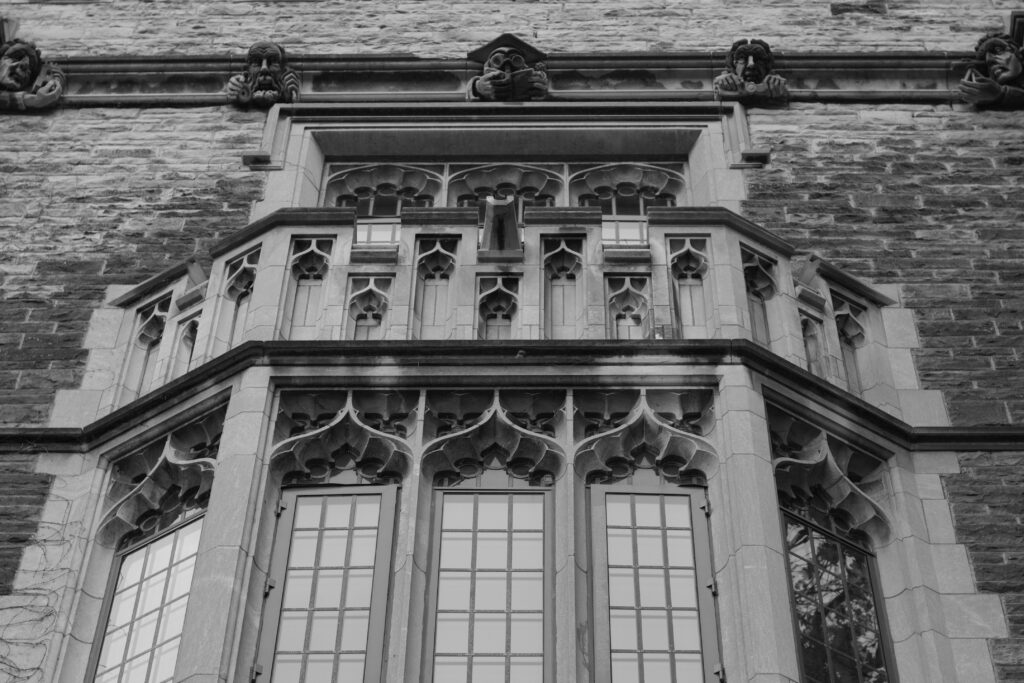
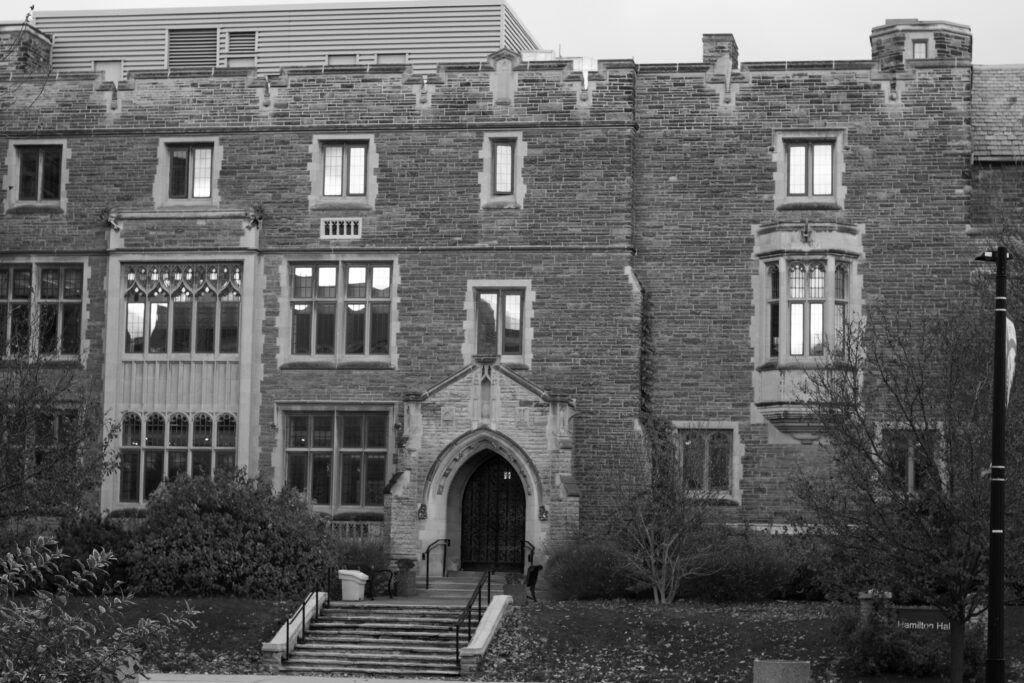
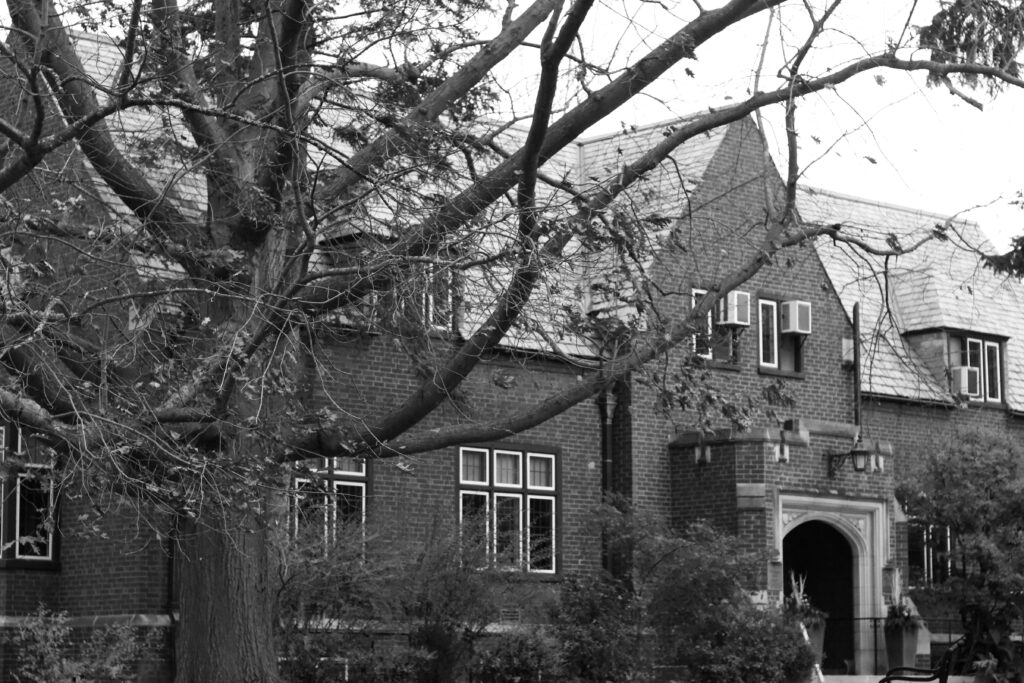
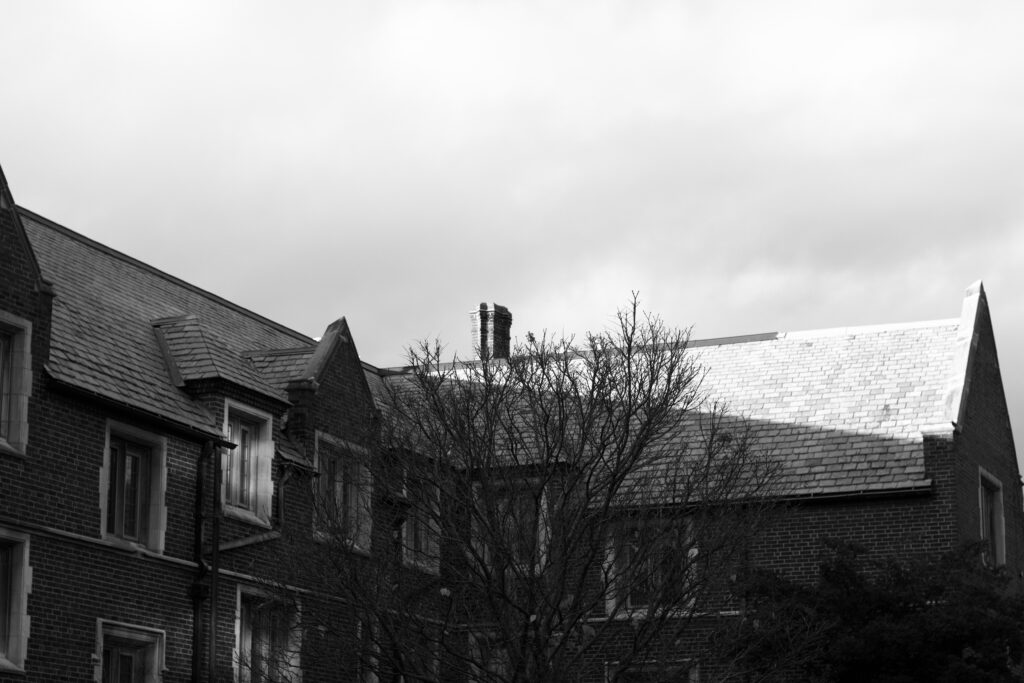
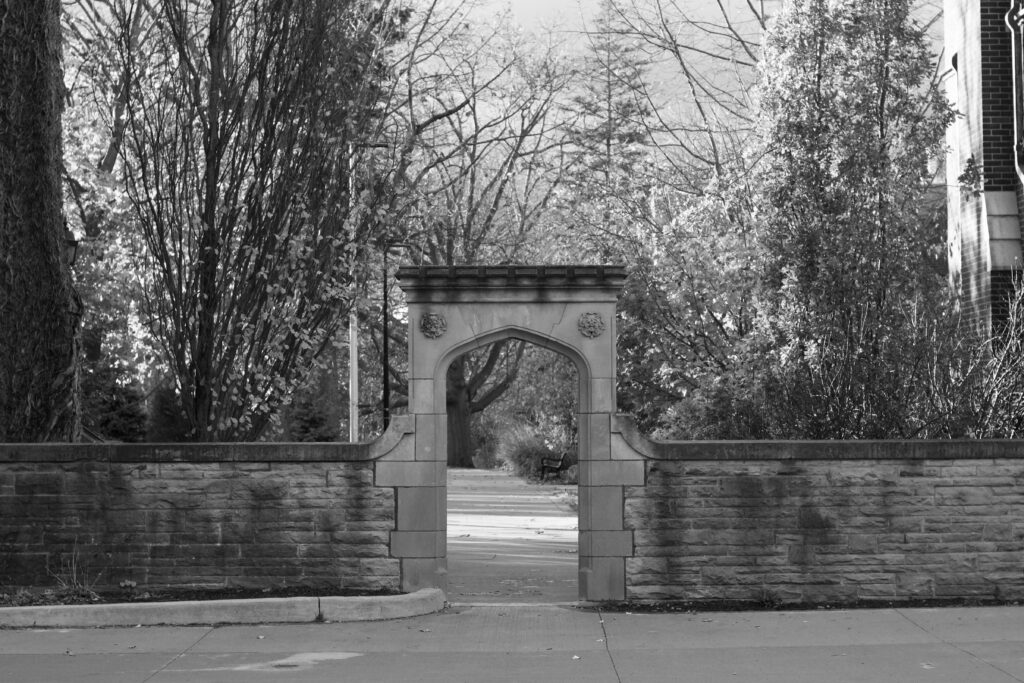
The McMaster Health Sciences Centre was designed by architect Eberhart Zeigler, with the intention of “never being finished.” The interior of the building was designed without the need for structural support walls, allowing for future modification.
This building was designed in the Brutalist architecture style that emerged in the mid-1900s and first opened in 1972.
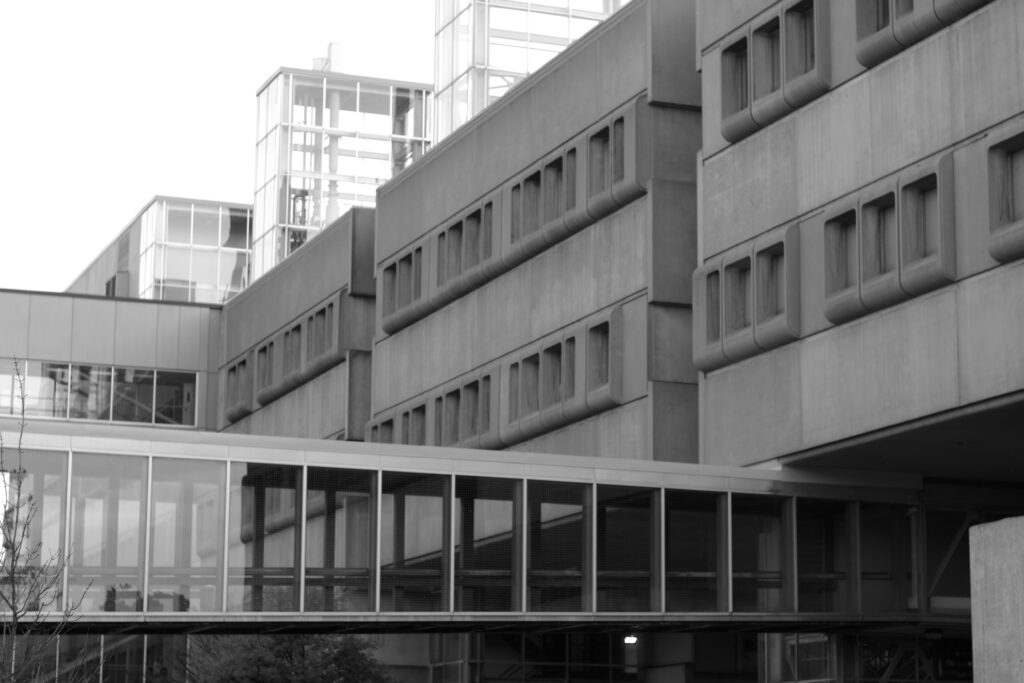
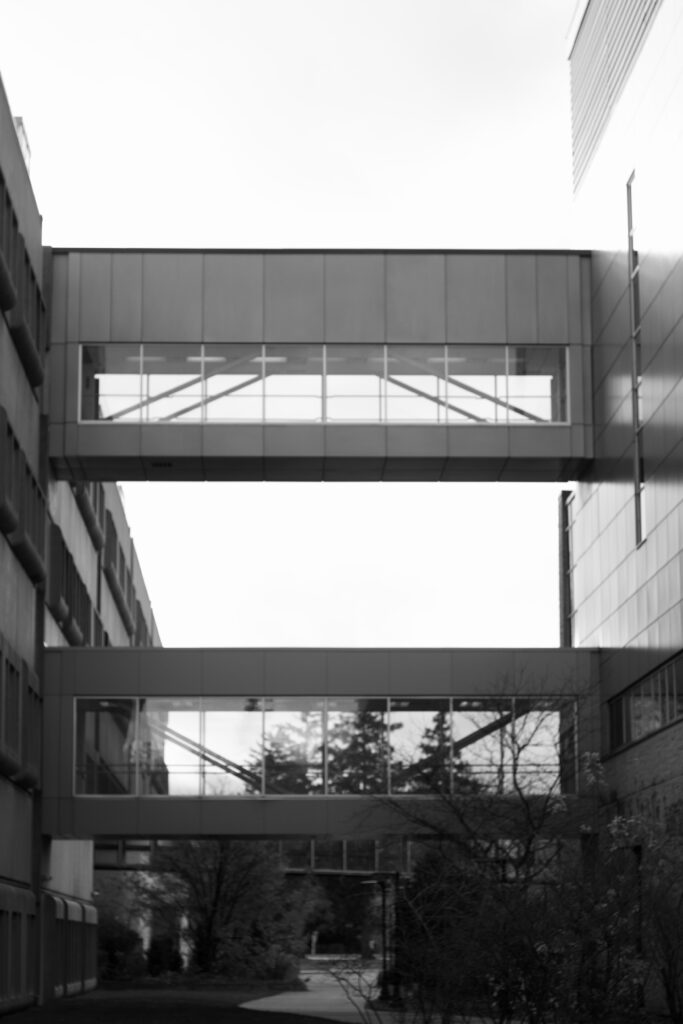
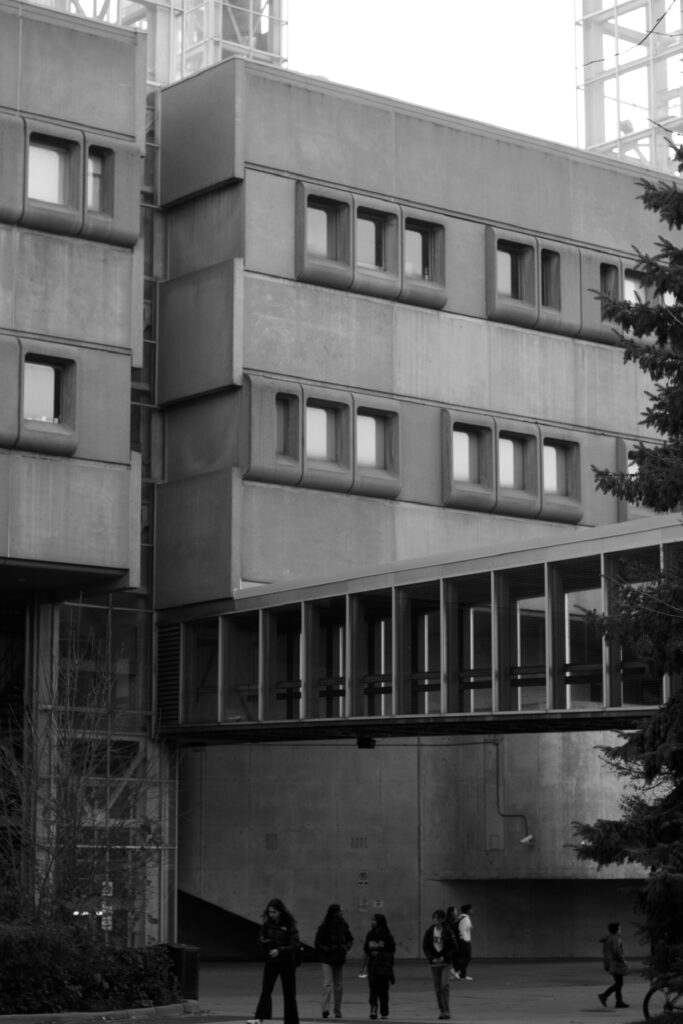
Among McMaster’s newest buildings are The Hub (2024), the Peter George Centre for Living and Learning (2019), and L. R. Wilson Hall (2017). L. R. Wilson Hall features a concert hall, blackbox theatre, interactive classrooms and an inner courtyard (pictured). The Peter George Centre was designed by architecture firm Diamond Schmitt. The four-storey atrium is naturally lit by a skylight and features a spiral staircase.
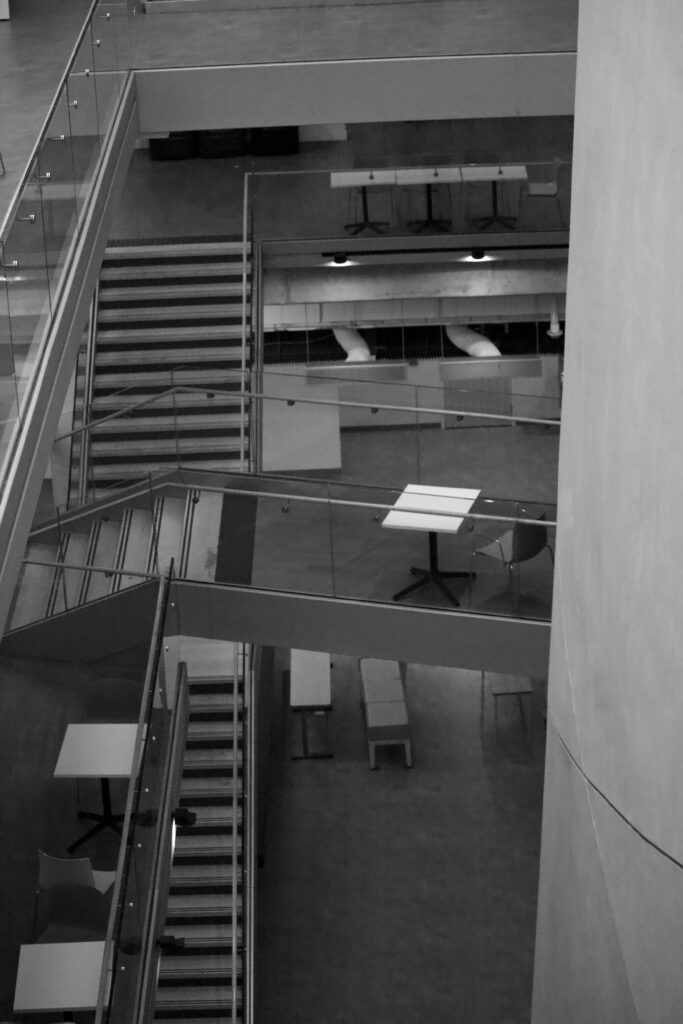
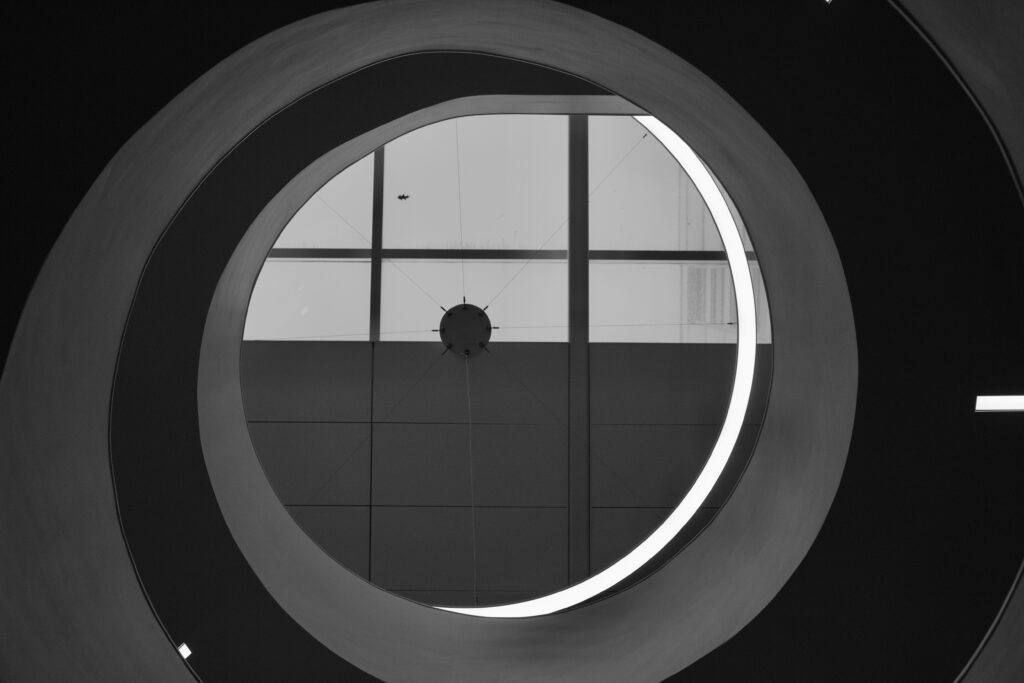
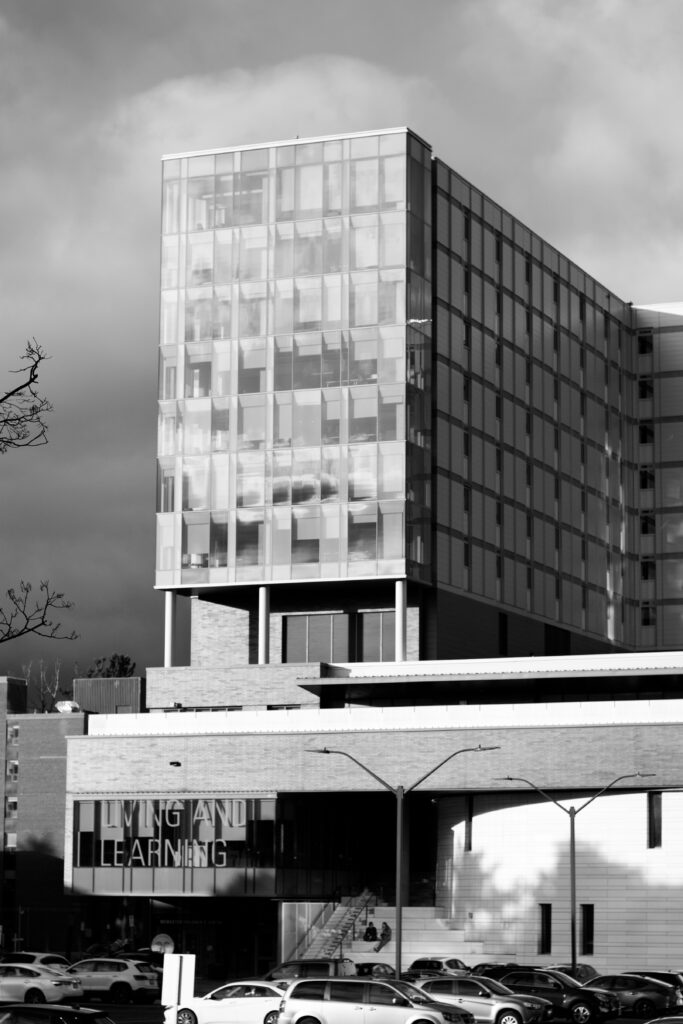
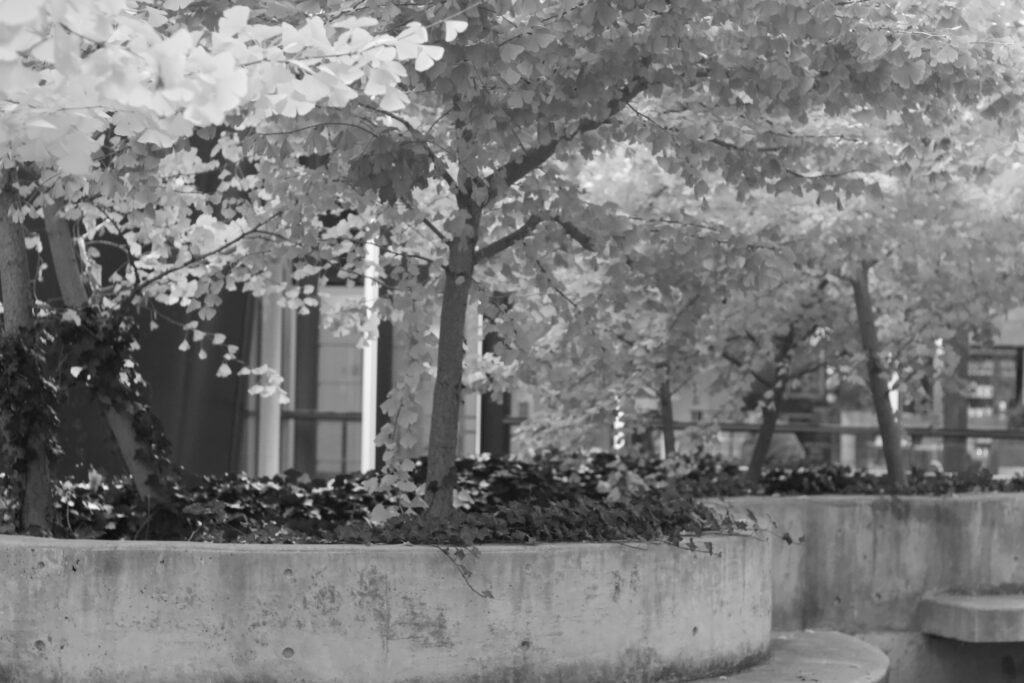
Art Gallery of Hamilton’s new exhibit shows the process behind digitizing art
Art has early origins and continues to be relevant today. It’s important to collect and record art as a way of documenting history. However, what happens when art is documented but not immediately put up for display? They become a part of a collection of pieces hidden from the world.
The Art Gallery of Hamilton aims to address this issue with its Collections Digitization Project which began in Spring 2022 and will conclude in Spring 2024. The project aims to digitize many of the works kept in the vaults at AGH.
Andrea Howard, digitization collections assistant, emphasized that as the AGH is a publicly funded resource, it’s important to provide the public access to pieces which aren’t always on display. Moreover, the project team is prioritizing putting on underrepresented artists, such as Black, Indigenous and Persons of Colour and women artists.
“It is a really necessary project because we have well over 10,000 objects in our collection. The physical space that we have here at the museum means that we can only display 5 per cent of those works at a given time. That means the bulk of our works are in a vault and they're hidden from the public,” said Howard.
“It is a really necessary project because we have well over 10,000 objects in our collection. The physical space that we have here at the museum means that we can only display 5 per cent of those works at a given time. That means the bulk of our works are in a vault and they're hidden from the public."
Andrea Howard, digitization collections assistant
The project is funded by the Museums Assistance Program, specifically the Digital Access to Heritage, which is a program of the Department of Canadian Heritage. The funds were important for hiring people for the project, obtaining necessary licenses and receiving commissions and equipment.
The project has many aspects, one of which is focused on showcasing the process of digitizing art works. This exhibition will begin on Feb. 11, 2023 and will include installations and a behind the scenes look at the digitization process. Howard’s hope is to connect with the general population and show the public how much work goes into digitization.
“A part of this project has become an exhibition, that is going to be launching on [Feb. 11]. That exhibition is in part a digitization lab [and] part installation where we exhibit works and show some kind of hidden digitization labor that occurs in art museums,” said Howard.
“A part of this project has become an exhibition, that is going to be launching on [Feb. 11]. That exhibition is in part a digitization lab [and] part installation where we exhibit works and show some kind of hidden digitization labor that occurs in art museums."
Andrea Howard, digitization collections assistant
Howard believes the Hamilton community will find the exhibit to be engaging. She’s worked closely with the AGH docents, who have shared positive feedback for the exhibit.
One of their more recent programs at AGH called Fridays at Four gives those curious a virtual look at the AGH’s permanent collection. Given the docents extensive knowledge on the collections within the museum, Howard is aware their feedback is vital. They’ve expressed how happy they are to see more pieces being digitalized and how they are being shared with visitors.
“I know from my experience with the docent . . . that they’re really excited about the growing number of images they are seeing and having access to. I know we have been getting a lot of engagement on social media with our images and I’m excited to see where it jumps off from there,” said Howard.
Currently, the AGH is working on three dimensional printing as part of the digitization project. The goal of this is to have art pieces 3D printed as a way to engage visitors in a new way. It will also allow for pieces to be preserved and protected, which is valuable in the storage of artworks.
“Our hope is to not only create 3D renderings that will live online, but also from those 3D renderings have some of our works 3D printed. That’ll be a really great way for the programming department to pass around our objects to feel,” said Howard.
The AGH hopes that people will come together to learn about the complex tools used to preserve artwork. They hope the project itself will be able to highlight work that isn’t always displayed and allow for work to be presented in a new format. The exhibit is one of the first ways in which visitors can see the direct process that goes behind digitizing works.
We’ve heard about the teams and the athletes, but what is it like being on the sidelines for games getting the shots that end up on social media?
Behind every great photo is a great photographer. Although McMaster University athletes earn their poise through good performances on and off the field, media personnel are those that are responsible for publication of their success to the wider audience, such as the students.
One of the main individuals that can be praised for creating a good image of McMaster sports is Kevin Lassl, a fifth year materials engineering student, who is also one of the primary photographers for varsity sports at McMaster. Being mostly responsible for volleyball and soccer games, Lassl is very passionate about photography and enjoys his job.
“Photography to me is a hobby, it has been something that I’ve been enjoying for a long time, so this job came around as a very handy opportunity. I remember seeing the job posting some time ago and decided to go for it, turns out it was such a good decision,” said Lassl.
Photography to me is a hobby, it has been something that I’ve been enjoying for a long time, so this job came around as a very handy opportunity. I remember seeing the job posting some time ago and decided to go for it, turns out it was such a good decision.
Kevin Lassl, one of the primary photographers for varsity sports at McMaster University
Something that the wider public doesn’t know about photography with the Marauders is that the employees get full flexibility with their work and can arrange in advance which games they’d be available for.
“My supervisors are very lenient flexibility-wise. Sometimes it can be hard for me to attend some games due to school related instances such as labs and midterms, but they always understand. It’s important for me to let them know in advance so they can allocate me to another game when I am free. I am also able to be assigned to a few sports to follow throughout the season, which in my case are men and women’s volleyball and soccer teams,” explained Lassl.
Another aspect of working as a photographer for the Marauders is the freedom to produce any photograph the employee wishes, with very limited restrictions. The freedom of range is significant, enabling creative confidence and allowing unique visions to flow.
“The great thing about the Marauders is that I don’t get commands on how I can take my photos. This means that I get to pick the angles, how to edit the photos and how many I can take during the games. This definitively makes the job a lot less stressful,” said Lassl.
The great thing about the Marauders is that I don’t get commands on how I can take my photos. This means that I get to pick the angles, how to edit the photos and how many I can take during the games. This definitively makes the job a lot less stressful.
Kevin Lassl, one of the primary photographers for varsity sports at McMaster University
Although Lassl has been chosen as one of the primary photographers for the Marauders soccer and volleyball teams this season, so far, he has only done his job at home games. Although away games would create intrigue, the home soil is where Lassl has spent his time this season.
“Over the past semester, I had the great opportunity to take photos at the Ron Joyce Stadium and David Braley Athletic Centre (DBAC), among other places. All these games were hosted by McMaster, so I still didn’t have the opportunity to go to any away games so far. Certainly, if my schedule allows it and I get a call up from the supervisor, it can be a possibility that I go to an away game soon.” said Lassl.
Photography is not an easy job, there is always a lot of pressure lurking on getting that one right shot that can be published around the school. More often than not, individuals focus on the athletes rather than the ones who help them achieve the publicity they deserve. Lassl is certainly one of those that has helped the soccer and volleyball teams through his great photography this season.
C/O @hamiltonartistsinc
Karice Mitchell's take care project with Hamilton Artists Inc. promotes self-care as a way of individual and collective healing
Displayed on the side of the black brick wall of Hamilton Artist Inc. is a billboard with the words take care printed on top of an image from a Black erotic publication. Through the photographic installation, artist Karice Mitchell hopes to re-appropriate and reclaim Black erotic imagery while also reminding Black folks, particularly Black women, to practice self-care.
Available until May 29, take care is the latest Cannon Project Wall installation at Hamilton Artists Inc.. The project accepts new proposal every year to showcase on the billboard outside of the organization’s building. Mitchell’s work has been up since July of last year.
Mitchell is a photo-based artist who works with found imagery mostly from Black erotic magazines published in the 1970s, 1980s and 1990s and manipulating them digitally. At its core, her work seeks to engage radically with Black women’s bodies and sexuality without influences from the white gaze and patriarchy. Mitchell obtained her master’s in fine arts last year and is currently lecturing in photography at the University of British Columbia.
The inspiration for take care came about during the height of the COVID-19 pandemic as issues around mental health and self-care became a rising concern. She was also inspired by a quote on self-care by Audrey Lorde, an African American writer and feminist.
“Caring for myself is not self-indulgence, it is self-preservation and that is an act of political warfare,” stated Lorde.
In this way, the installation and the act of self-care seek to counteract the historical and present mistreatment, discrimination and oppression Black folks and Black women experience. It symbolizes resistance and resilience in the face of societal pressures and injustices.
“This work seeks to unapologetically represent blackness as a site of resistance. The words take care gesture to the importance of carving space for Black women to take care of themselves and how self-care can be a radical act,” said Mitchell.
"This work seeks to unapologetically represent blackness as a site of resistance. The words take care gesture to the importance of carving space for Black women to take care of themselves and how self-care can be a radical act."
Karice Mitchell, Photo-Based Artist
The work’s location in a public and easily accessible space also alludes to the concept of healing as a collective.
“Rarely, if ever, are any of us healed in isolation. Healing is an act of communion,” stated Gloria Jean Watkins, also known by her pseudonym bell hooks.
Mitchell wanted to represent the same ideas of a community self-indulgence in hooks’ quote and further drive home its point by having it displayed on a hard-to-miss outdoor billboard.
In the past several months, the display has garnered a positive response from the community. Going into the project, there were concerns regarding how it may be perceived as it deals with topics of bodies, nakedness and sexuality. However, she was pleasantly surprised about the support she received on the project.
“The work is really important for me. It was really important for me to show Black body in this public display — like the display of skin — to kind of monumentalize it in a particular way,” said Mitchell.
"The work is really important for me. It was really important for me to show Black body in this public display — like the display of skin — to kind of monumentalize it in a particular way."
Karice Mitchell, Photo-Based Artist
Reminders of self-care are great, but how do we practice self-care? Acts of self-care is individualized and they can look different for different folks. However, the take care artist suggests a few ideas. In her personal life, Mitchell engages in self-care by checking in with loved ones and friends.
“I think [checking-in with people] is really important if you have the capacity to do so, especially with the pandemic, when it can feel so isolating. Now more than ever, community and communion are so important and integral to our own development and care,” said Mitchell.
Mitchell also emphasizes the importance of enjoying small moments in life. Whether you like going on walks, meditating or stretching, taking time to indulge in inner reflection is critical.
“I encourage, notably Black women, Black folks and Black friends, to take care of themselves. It’s a radical act and an act of self-preservation that I think is crucial to our existence and well-being,” said Mitchell.
"I encourage, notably Black women, Black folks and Black friends, to take care of themselves. It’s a radical act and an act of self-preservation that I think is crucial to our existence and well-being."
Karice Mitchell, Photo-Based Artist
Project take care forces its audience to reconceptualize self-care as a political display of resistance, partially as a way of healing from the past and in current times of uncertainty and political polarization.
C/O Lianhao Qu
The Silhouette: Please introduce yourself.
Lianhao Qu: My name is Lianhao. I'm in my second year of [the health sciences program] and specializing in child health. My pronouns are he/him.
What drew you to photography?
I think it was when my dad bought me my first [digital single-lens reflex camera] for Christmas in my second year of high school. I think my dad mainly wanted it for family photos since I'm the designated family photographer. But then I got distracted because we go in nature a lot. I took fewer photos of my parents and my sister and just started shooting nature. This eventually progressed to the city, architecture and it evolved from there.
What subjects inspire you?
I usually lean towards landscape photography. I’m mostly in the city so it usually ends up being a lot of city architecture. I've also tried to get into shooting candid photos of strangers. I just basically go into the city, [with] no plan whatsoever, and take a photo of whatever catches my eye. But really, it's just shooting anything in the streets. Whether it's the buildings around you, the way the light reflects off the water or the water reflecting buildings. Small things like that.
How long have you been interested in photography?
I only really got into it in my later years of high school. I really enjoyed photography as a hobby and sometimes as a side hustle too. There was one summer where I was a freelance photographer. I worked with a union at one point and I was the photographer for this unit who was a part of the parade for the Caribana Festival. I got to go early in the morning and see all the dancers prep and everything. It was a fun experience — definitely out of my comfort zone — but it was a nice change.
Out of your own photos, do you have any favourites?
I think this one's the most pleasant for me to look at. It's just very calm and is a nice background to look at. This was in North Bay at Lake Nipissing right after dinner. I had to leave dinner, actually, run to my hotel to grab my stuff and then I ran back to the lake just to make it in time. I set the tripod up in the water and I looked ridiculous. The hotel owner saw me suddenly running around the street. But the photo is nice.

And then there's this photo. The style is different from what I usually do. This is when quarantine happened. I just searched around for ideas so I could take photos at home. I had the knife already pre-stabbed into the cutting board and one of the apple halves hanging from above. There was a flashlight above too and the lighting is very botched because you have to take this at a very high shutter speed. My mom had to splash water and drop the apple and then I just had to go to take the photo at the right moment.

This is my most viewed photo. As popular as this photo is, I'm not a big fan of it. I think the main reason is this was one of the first photos that kind of blew up. This is when I first got into editing as well. So, to me, the colours here are so saturated and if you look in the far distance, you can see the colours are off.

What is the hardest aspect of photography for you?
Sometimes you go to extreme lengths just to get the right angle for a photo so you look kind of weird. On the first day, it can be frightening when you're in public and you're holding this huge camera and you just stop in the middle of the road. But you have to get rid of that scary thought of how you look in public. I stopped caring what people think of me and I stop in the middle of the road. I don't recommend doing exactly that but the thrill of the photo also makes it fun. Another thing is not forcing yourself to find that perfect angle or photo. Most of my photos I find nice are complete accidents. Usually I'm planning how to get there and how to set up my stuff to take that photo but sometimes it just doesn't turn out the way you want. The photos you take some other day tend to be a lot better and they tend to be complete accidents. Let it come naturally. Don't force it.
C/O Klaudia Piaskowska
An over-reliance on digital photos causes more harm than we may expect
By: Rankini Kulatilake, Contributor
From my first ultrasound to my high school graduation, my mother’s scrapbook has captured all my milestones. If anyone wanted to know my story, a simple look through that scrapbook would reveal everything. Yet, 18 years later, in the age of digital photographs and phones with multiple cameras, my mother still chooses to carry a disposable camera around to capture the excitement of the world around her.
Though digital photographs are quick and often high quality, it has caused meaningful pictures to have increasingly lost their uniqueness given the number of pictures that can be taken so quickly. This idea is based on the fact that we depend on digital photographs to remember the experience, notwithstanding the fact that we have an abundant amount of digital photographs, which can get easily lost in the abyss of our “Photos” app.
A study of undergraduate students was performed as a guided tour of a museum, prompting the students to take pictures of some objects and just simply observe others. The results? The students remembered fewer visual details about the photographed art, in comparison to the art they were asked to only observe.
The study found that this difference is due to our over-reliance on the camera, rather than our memory. Consequently, we lose small details and fail to activate the processes that allow us to remember these important details. In short, digital photographs lose their meaning due to our overdependence on the camera itself, causing us to forget important details that would enhance our memory of our experiences.
Digital photographs are easy to take, quick to save and you can easily take 100 pictures in the span of a mere two minutes. In 2018, an estimated one trillion photos were taken. This gargantuan number of photographs will only grow as time goes on. Even in our own phones, we have a flood of pictures.
But how many of those do we look back at? How many of those experiences do we remember? My camera roll is around 1,000 pictures; however, most of these would be collecting dust if they could. Very rarely will I look back on these pictures because there are simply too many of them and they all blend in together. Many of them have lost their significance as they’ve blended in with the excessive amount of random screenshots and memes I have stored.
In other words, though digital photos are efficient, the large quantity of them in our phones makes them easily forgettable and causes them to become virtually meaningless.
However, are physical photographs any better? With digital photographs, you can easily share them with your family members and friends who live far away. You’ll even have it there forever, no worrying over losing it or damaging the picture. Despite this, digital photos do not equal security. They can be lost just as easily as physical photographs, albeit in a different manner.
According to technology developer Vincent Cerf, our most fond and precious memories that are stored digitally risk being lost due to the rapidly evolving changes in digital technologies.
If we look to compact discs as an example, many used this as a storage unit for a variety of different media types. For a while, you could insert a CD on your laptop as they came with CD players built-in. However, most new laptops do not come with a CD player built-in. Similarly, with the USB, those important files are always easily corrupted and vulnerable to being lost.
This issue is not seen with physical prints, as photo printers have evolved from being at your local supermarket to mobile printers that you can carry in your bag and connect to a device. All in all, even though physical photographs cannot be as easily shared across vast distances as digital photographs, they can be securely stored and have withstood the rapid advancements of digital media technologies well.
Thus, the rise of digital photographs has caused photos to lose their meaning and significance. This is due to the fact that we remember less of our experiences when we rely on digital photos, as well as the fact that our digital photos are overflowing in our camera rolls. As well, digital photos are constantly vulnerable to the ever-changing media technologies.
That being said, we can easily capture every moment now, but does it really equate to a memorable and meaningful experience if you are merely viewing it through a phone screen? A picture may be worth a thousand words, but, oftentimes, a thousand words are just not needed.
By: Esther Liu, Contributor
The Silhouette: What inspired you to start @hamontsalsa?
Salsa Sarhan: I used to have a One Direction fan page and I used to make edits. That's what inspired me. I realized I could take my own photos and incorporate my own stuff. I had a little iPod [5th generation] that I used to take photos and then I realized that I'm actually getting good at this. So then I made my own little photography account.
People started liking my photos, reposting them online and I realized that I kind of have a knack for this! So I focused solely on that. Last year, I started actually selling my prints. People kept on asking if I have a website—I don't have a website just yet, I'm still working on it—but people are buying my prints, which is really exciting. So if you need a print, let me know!
What are your goals for @hamontsalsa, both short term and long term?
My short-term goal is to sell 100 prints. So far I've sold 40, so I'm doing pretty good for the beginning of this year. Long term, I definitely want to open up my own studio and then show people photography tips and show them how to get started, even with an iPod 5. Having a studio would be huge for me, but that's definitely a long-term goal, after university, after all those student loans are paid off.
How are you finding running the project during the pandemic?
Honestly, it's very hard cause I'm not as active as I used to be in the summer, where you could be going on walks and everything looked sun-kissed and beautiful. During the pandemic, everything does feel a little bit more gloomy, especially with the semester being so heavy. So having it as a side-project right now is kind of inspiring since I can relax, know that it's still there and I can always go to it and be happy.
During the pandemic, everything does feel a little bit more gloomy, especially with the semester being so heavy. So having it as a side-project right now is kind of inspiring since I can relax, know that it's still there and I can always go to it and be happy.
Do you see yourself continuing @hamontsalsa when you graduate?
Oh yes, definitely. But I feel like it's gonna be less architecture and buildings that I see when I'm going on walks. When I graduate, I want to focus solely on people and people’s stories. I've always wanted to do portrait photography, but I never got a chance to practice. After graduation, I could focus on different realms of photography since I'll have more free time considering that I'm not stressing and doing school work.
Could you elaborate on why you're so interested in photography?
I know it's a little bit cliché, but I think it's a fact that I can capture things in my own perspective. That is huge for me because I like being very vocal about who I am and what I stand for. So definitely being able to capture a perspective that's mine and knowing that no one else can change it but me.
I know it's a little bit cliché, but I think it's a fact that I can capture things in my own perspective. That is huge for me because I like being very vocal about who I am and what I stand for. So definitely being able to capture a perspective that's mine and knowing that no one else can change it but me.
You can see from the beginning of my feed to now, there was a huge improvement and change in the type of photographer I was and the places I was going to, how I see different angles.
Could you elaborate a little bit more on how you think your project has evolved?
It's definitely evolved with the way that I'm actually perceiving things in Hamilton. It's not just me going on a walk and seeing a nice random building, it's me looking at different angles of that building, now appreciating the texture, the textiles of it.
So it's definitely me growing as an artist and then that definitely shows in the improvement of my photography. Like I said before, like, long-term goal, I do want to focus more on portrait photography and the people within those photos. Being able to grow as a photographer is just a huge thing.
What camera do you use?
Here's my biggest trade secret: I don't use a camera. That's my biggest trade secret. I just use my [iPhone] 8 Plus.
Do you have any hot spots in Hamilton that you really like to take photos of?
Bayfront is such an easy place to get inspired 'cause it's always changing, there's always something new. Number two, I would say Locke Street. There's so many different colours and paintings [and] everything looks like it's from a different era.
And number three . . . this one's basic, but I really like Mulberry [Café]. I'm there almost every single day to say hi to my barista friends, but that place is so photogenic. They have these huge windows so lots of good natural light comes in and the actual structure inside is so cute. They have these brick walls and even the lights are adorable.
And then, let me think of a fourth one. Oh! Aberdeen [Street]! Aberdeen has some gorgeous houses, some look like mansions. So, you could pop in an address, look cute and pose."
Thomas Brasch’s popup photography installation is making art accessible in these dark days
Art is often something we turn to when things are difficult, something we seek comfort and solace in. Not only is art something bright during the dark days, but it also can tell us stories that help us to imagine brighter days for ourselves.
These stories become part of our own, giving us new courage and strength to face these trying times. One such story is Thomas Brasch’s popup photography installation at 267 King St. E., which is making art more accessible while also bringing some hope and light to Hamilton.
View this post on Instagram
Brasch graduated from McMaster University with an honours bachelor of arts in french literature and returned to McMaster to complete a master’s of business degree. He went on to become a high school teacher. During Brasch’s time as a teacher, he developed an interest in photography.
After retiring, he travelled extensively and began to explore and experiment further with photography. Brasch primarily takes photos of nature and architecture and then transforms them into these round images, similar to kaleidoscopes or mandalas.
“One curator said [to me] that mandalas are actually memory palaces and your walk through them [helps] you meditate. So again, it's this idea of calming . . . it’s not just the image. In fact, it's never about one image. It's about a whole series of images that actually tell the story,” explained Brasch.
"One curator said [to me] that mandalas are actually memory palaces and your walk through them [helps] you meditate. So again, it's this idea of calming . . . it’s not just the image. In fact, it's never about one image. It's about a whole series of images that actually tell the story."
Stories are important to Brasch and a large part of why he creates art is to share these stories. From a distance, each of his photos may be beautifully abstract but if one takes a closer look they may be able to recognize the original image and see the story built into it.
Recently, Brasch reconnected with one of his McMaster classmates, Maya Premlata Rao. She loved Brasch’s art and the current installation was her idea. The building where his installation currently is belongs to Rao. The installation features unsold pieces from two of Brasch’s previous collections, Out of Darkness and Tapestry.
View this post on Instagram
“I think the whole goal with Maya and I was to share this with people in Hamilton. Yes, initially, there was the allure of getting more exposure and maybe somebody would show an interest or something. [Maya] is one of these people who is into good energy and everything. There was a good energy coming off of this,” said Brasch.
This installation is Brasch’s way of giving something to the community during these trying times, but it has also helped him realize the need to make art more accessible, especially to those who would not be able to visit a gallery, even if we were not in lockdown.
This installation is Brasch’s way of giving something to the community during these trying times, but it has also helped him realize the need to make art more accessible, especially to those who would not be able to visit a gallery, even if we were not in lockdown.
When Brasch was first setting up the exhibition, a passerby stopped to admire the art and asked if Brasch had an artist’s postcard to share. He hadn’t planned on having one and as such didn’t have one to offer to this passerby.
“He said, “Well, I'm a little short of cash and I collect these” and that's when the veil got pulled away from my eyes. I had the big aha moment . . . I thought, “Here I am, I have the opportunity of sharing this art with somebody who actually enjoys it”,” explained Brasch.
Brasch strongly believes that art is meant to be shared. More than that though, he believes the stories behind art are also meant to be shared, particularly stories of hope.
View this post on Instagram
“The source image is from a prison, but the prison is the oldest prison in Uruguay. It closed in 1986 [and] it's become an art gallery. So it's that whole idea of something bad coming into something good. It’s a place for people, for creation, [for] freedom of expression. All of this is able to be there,” explained Brasch.
These kinds of stories are something he feels is sorely needed during these times, but more generally he hopes that people will come away from his art feeling a bit lighter and having found what they needed.
“I just want somebody to go and be able to take a look and just feel, even if it's just a little bit, a little bit of a feel-good moment. They may not know the whole story. They may not have checked the website or anything. If it looks like Christmas ornaments to them, that's fine,” said Brasch.
"I just want somebody to go and be able to take a look and just feel, even if it's just a little bit, a little bit of a feel-good moment. They may not know the whole story. They may not have checked the website or anything. If it looks like Christmas ornaments to them, that's fine."
The current installation will be on display until the end of February.
Hamilton photographer demonstrates the importance of exploration through photos
On Jan. 1, 2020, lifestyle and boudoir photographer Iryna Kostichin posted her first photo of Hamilton to her then-new Instagram page, 365 Days Of Hamont. The photo of the residential street was the first step in a project intended to showcase all that Hamilton has to offer.
Although Kostichin was born and raised in Hamilton, she didn’t truly start exploring the city until after she graduated from McMaster University in 2017 with a degree in social psychology. She moved out for the first time and was figuring out what she wanted to do with her life. It was in the period of self-discovery after graduation that she began exploring the city.
View this post on Instagram
During this time, she also returned to photography, a passion of hers from childhood that she had put aside as a viable career choice.
“A few years ago, I was in a really rough spot. I was graduated and I had a degree and I was in a job that I really didn't like . . . and I was like “I really don't want to do this for the rest of my life. I need to find something where I work for myself and I'm responsible for everything, job-wise”. So I ended up getting a social media coordinator job and then that year I was exploring portrait photography," said Kostichin.
Kostichin wanted to put her social media skills towards a project that showcases her hometown’s beauty and combats its bad reputation, leading to 365 Days of Hamont. To gather the photos for the page, she goes on a few weekly adventure walks, taking pictures of places and objects she passes. Her goal is to show various representations of Hamilton, from the buildings to nature to food.
Kostichin wanted to put her social media skills towards a project that showcases her hometown’s beauty and combats its bad reputation, leading to 365 Days of Hamont.
The project began as a commitment to posting daily in 2020, but over the year, this plan changed as Kostichin found the daily commitment challenging. Now over a year after the project began, Kostichin is a little over halfway through her original 365 days.
View this post on Instagram
The pandemic also limited how much she was able to explore the city because she doesn’t have a car. It has also been difficult to explore new destinations when lockdowns have closed many places in Hamilton. However, despite these challenges, Kostichin is looking forward to diving back into the project this year.
“So definitely next steps are continuing on this journey and not putting so much pressure on myself to do it every single day . . . I started out thinking I was going to post every day and get all this engagement and get to the end of 365 days, right? But realistically I haven't reached that and exploring Hamilton really isn't only a 365-day project. So I can live a whole lifetime and still not see the whole city, which is exciting I guess. So I'm just excited to continue to carry the torch and help others explore the city,” said Kostichin.
"So I can live a whole lifetime and still not see the whole city, which is exciting I guess. So I'm just excited to continue to carry the torch and help others explore the city."
For students in Hamilton that are looking to explore, Kostichin suggests taking it one neighbourhood at a time. Especially during COVID, she suggests picking a neighbourhood and just walking around it.
As her exploration of the city is tied to her self-exploration, the latter is also very important to Kostichin. Through her boudoir photography business, she is encouraging individuals to explore new parts of themselves. Her own journey from social psychology major to full-time photographer and business owner is proof of the importance of self-discovery.
View this post on Instagram
“I use psychology in my day-to-day life. Even in a social media job, a lot of it is psychology. Then being in a social media job also using photography and really discovering that aspect of myself and bringing it back and now I'm actually going to be like a full-time photographer this year and start my own business. So just because people tell you [that you] can't do it really doesn't mean you can't do it, because here I am with a university degree and I'm making money from something that I taught myself,” said Kostichin.
"So just because people tell you [that you] can't do it really doesn't mean you can't do it, because here I am with a university degree and I'm making money from something that I taught myself."
Kostichin’s story shows that with hard work and a little exploration, students might be able to turn their time at McMaster into the life of their dreams.